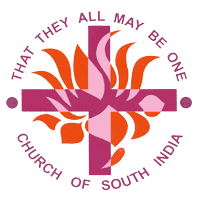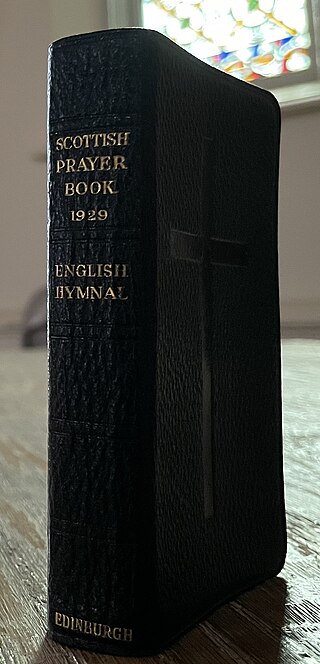The Scottish Episcopal Church is the ecclesiastical province of the Anglican Communion in Scotland.

The Free Church of England (FCE) is an episcopal church based in England. The church was founded when a number of congregations separated from the established Church of England in the middle of the 19th century.
The Continuing Anglican movement, also known as the Anglican Continuum, encompasses a number of Christian churches, principally based in North America, that have an Anglican identity and tradition but are not part of the Anglican Communion.

The Church of South India (CSI) is a united Protestant Church in India. It is the result of union of a number of Protestant denominations in South India that occurred after the independence of India.

The Reformed Episcopal Church (REC) is an Anglican church of evangelical Episcopalian heritage. It was founded in 1873 in New York City by George David Cummins, a former bishop of the Protestant Episcopal Church.

The Cathedral Church of the Advent in Birmingham, Alabama, is the see church of the Episcopal Diocese of Alabama. On March 30, 1983, the structure was added to the National Register of Historic Places as the Episcopal Church of the Advent.

The Episcopal Diocese of Georgia, USA is one of 20 dioceses that comprise Province IV of the US Episcopal Church, and is a diocese within the worldwide Anglican Communion. The current bishop is Frank S. Logue, who succeeded Scott Anson Benhase on May 30, 2020, when he was consecrated 11th bishop of Georgia at a service held in Christ Church in Savannah, Georgia.

The Spanish Reformed Episcopal Church, also translated as Reformed Episcopal Church of Spain, or IERE is the church of the Anglican Communion in Spain. It was founded in 1880 and since 1980 has been an extra-provincial church under the metropolitan authority of the Archbishop of Canterbury. Its cathedral is the Anglican Cathedral of the Redeemer in Madrid.

The Anglican Province of America (APA) is a Continuing Anglican church in the United States. The church was founded by former members of the Episcopal Church in the United States.

The Episcopal Diocese of Pittsburgh is a diocese in the Episcopal Church in the United States of America. Geographically, it encompasses 11 counties in Western Pennsylvania. It was formed in 1865 by dividing the Episcopal Diocese of Pennsylvania. The diocesan cathedral is Trinity Cathedral in downtown Pittsburgh. The Rt. Rev. Ketlen A. Solak was consecrated and seated as its current bishop in autumn 2021.

St. Gregory's Abbey is an American monastic community of men living under the Rule of St. Benedict within the Episcopal Church. The abbey is located near Three Rivers in St. Joseph County, Michigan.

The Episcopal Diocese of Newark is a diocese of the Episcopal Church in the United States of America comprising the northern third of New Jersey in the United States. The Diocese represents the Anglican Communion, of which the Episcopal Church is a province, and presides over Episcopal parishes, missions, outreach ministries and schools in the New Jersey counties of Bergen, Essex, Hudson, Morris, Passaic, Sussex, Warren, and one church in Union County.

The Episcopal Diocese of Indianapolis, formerly known as the Episcopal Diocese of Indiana, is a diocese in Province V of the Episcopal Church. It encompasses the southern two-thirds of the state of Indiana. Its see is in Indianapolis, Indiana, at Christ Church Cathedral. According to the diocesan newsletter, the diocese has 10,137 communicants in 49 parishes. The current bishop is Jennifer Baskerville-Burrows, the first African-American woman to serve as diocesan bishop in the Episcopal Church and the first woman to succeed another woman as a diocesan bishop in the Episcopal Church; Catherine Waynick served as bishop of the diocese from 1997 to 2017.

Anglican interest in ecumenical dialogue can be traced back to the time of the Reformation and dialogues with both Orthodox and Lutheran churches in the sixteenth century. In the nineteenth century, with the rise of the Oxford Movement, there arose greater concern for reunion of the churches of "Catholic confession". This desire to work towards full communion with other denominations led to the development of the Chicago-Lambeth Quadrilateral, approved by the Third Lambeth Conference of 1888. The four points were stipulated as the basis for church unity, "a basis on which approach may be by God's blessing made towards Home Reunion":

The Episcopal Church (TEC), based in the United States with additional dioceses elsewhere, is a member church of the worldwide Anglican Communion. It is a mainline Protestant denomination and is divided into nine provinces. The presiding bishop of the Episcopal Church is Michael Bruce Curry, the first African American bishop to serve in that position.

The Anglican Diocese of the Living Word, formerly the Missionary Diocese of CANA East, is a diocese of the Anglican Church in North America (ACNA). It was one of the four missionary dioceses of the Convocation of Anglicans in North America, a dual church body of the ACNA and the Church of Nigeria. It is officially a full member diocese of ACNA since June 2013. It comprises 43 congregations in 19 American states, with congregations as far as California and Florida but with most concentrated in the northeastern and mid-Atlantic regions. The diocese is divided into nine archdeaconries: Central New York, the Chesapeake, Long Island, the Mid-Atlantic, the Northeast, northeastern New York, the Ohio Valley, the South and the Midwest. The diocese also sponsors a mission in Haiti that includes nine additional congregations. The diocesan office is located at McLean, Virginia. The diocese also includes two affiliated religious communities: the Franciscan Brothers of Bucksport and the Community of St. Mary (East) in New York.

The 1929 Scottish Prayer Book is an official liturgical book of the Scotland-based Scottish Episcopal Church. The 1929 edition follows from the same tradition of other versions of the Book of Common Prayer used by the churches within the Anglican Communion and Anglicanism generally, with the unique liturgical tradition of Scottish Anglicanism. It contains both the forms of the Eucharistic liturgy and Daily Office, as well as additional public liturgies and personal devotions. The second major revision of the Book of Common Prayer following the full independence of the Scottish Episcopal Church, the 1929 Scottish Prayer Book succeeded the 1912 edition and was intended to serve alongside the Church of England's 1662 prayer book.

The Church of the Resurrection is an Anglican church in Wheaton, Illinois. It is the cathedral parish of the Anglican Diocese of the Upper Midwest, whose first and current bishop was Rez's longtime pastor. Since its founding in 1954, the church has had a significant and complex role in the Anglican realignment in the United States, the charismatic renewal movement and the growth in the so-called "Canterbury Trail" of evangelical Protestants moving toward Anglicanism.
Peter F. Manto is an American Anglican bishop currently serving as bishop ordinary of the Reformed Episcopal Church's Diocese of the Central States.

The Islamic Awareness Center, also known as Masjid Al-Tawheed, is a mosque and Dawah institution for the purpose of Islamic proselytization in Binghamton, New York. Since 2011, the Islamic Awareness Center has been located in the historic former building of the Episcopal Church of the Good Shepherd. In 2010, after the Good Shepherd congregation left the Episcopal Church as part of the Anglican realignment and lost a lawsuit to keep its property, the Episcopal Diocese of Central New York controversially sold the building for far less than its appraised value to the Islamic Awareness Center rather than to the departing Anglican congregation.


















